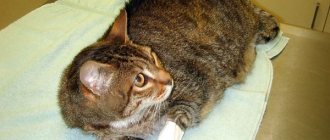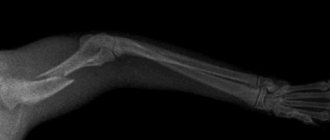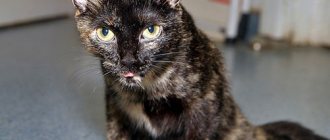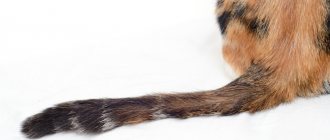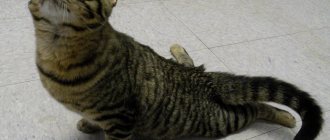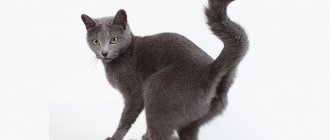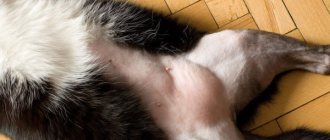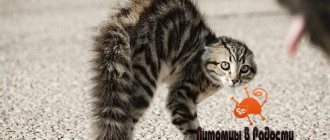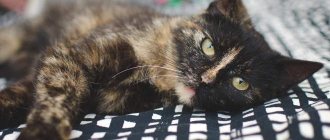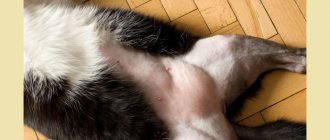A cat's paw fracture is more common than other types of mechanical injuries and represents a violation of the integrity of bone structures, as well as other tissues closely adjacent to them (ligamentous apparatus, muscle fibers, blood vessels and nerves).
The cause of a fracture (fracture) is injury as a result of a fall from a great height, a traffic accident, or a dog attack on a cat. A cat’s limb can also suffer due to the development of pathological processes affecting bone structures.
It is recommended to contact a veterinary hospital, where a specialist, after examination and diagnostic measures, will draw up a further treatment regimen.
Causes of the disease
A fracture is a violation of the anatomical integrity of the bone and adjacent tissues. It can be acquired or congenital and occur under the influence of external force or pathology, respectively.
If we talk about congenital pathologies of the bone structure, they are diagnosed in only 1-2% of the total number of visits to veterinary clinics with fractures. The reasons for the birth of kittens with fractures of the limbs are intense labor of the uterus, osteoporosis, rickets, osteomalacia in the expectant mother.
Veterinarians distinguish two types of acquired bone injuries based on the cause of their occurrence: pathological and traumatic. The first group includes fractures that occurred as a result of osteosarcoma, osteomalacia, etc.
Traumatic fractures occur not only due to various injuries received as a result of falling from a height, being run over by a car, or fighting with an opponent, but also due to unprofessional obstetric care.
Unlike a fracture, a dislocation is a violation of the anatomical location and a change in the physiological functions of the joint. The bone remains intact. Dislocations are also divided into two categories: acquired and congenital. The causes of dislocations are similar to fractures.
Not a single animal is insured against acquired dislocations and fractures. Breeds such as Persians, Maine Coons, and Himalayan cats are predisposed to congenital joint pathologies.
Damage detection
How can you tell if your cat has broken its leg? You can easily find out about the presence of a fracture. If an animal is unable to step on a limb while walking on three legs, then it most likely has an injury.
The presence of a pelvic fracture in pets can be determined if they are unable to stand up on their own. Abnormal mobility of the bones will also indicate an injury. It should also be noted that the area where the fracture occurred will swell over time. There will be a change in the anatomical shape.
The video shows what a cat looks like in a plaster cast.
Main symptoms
In case of fractures and dislocations, the animal exhibits general clinical signs: pain, impaired motor function (lameness), swelling of the damaged area.
There are three types of fractures: closed, open, and displaced. Serious damage also includes cracks.
Signs of an open fracture in a cat:
- violation of the integrity of the skin;
- the bone is broken, its ends are displaced and protrude;
- tissue rupture in the fracture area;
- bleeding;
- strong pain.
With open wounds, the risks of tissue necrosis and infection are very high.
A closed fracture without displacement is characterized by the following symptoms: the broken bone is in its usual position, the skin and tissues swell, turn blue, and turn red. In a displaced fracture, the bone diverges in different directions, and the soft tissue is partially damaged. There is a danger of internal bleeding.
A crack can easily be confused with a bruise. The bone remains intact, its edges do not diverge and are held in place by the undamaged area. The cat may move carefully, but it may be in pain.
A simple dislocation is recognized by the following signs:
- skin and tissue remain intact;
- lameness;
- inability to lean on the surface;
- pain when touching the injured limb;
- The dislocated part of the body is asymmetrical.
A complex dislocation, accompanied by rupture of ligaments and tendons, is characterized by the appearance of hematomas in the injured area.
First aid
Algorithm of actions:
- If there is a bleeding wound, you should initially stop the bleeding and clean the wound surface of foreign objects. You can stop the bleeding with a sterile bandage, a clean cloth, and pressing the swab against the wound. If there is heavy bleeding from a damaged vessel, applying a tourniquet or bandage above the site of injury will help. The tourniquet should remain on the paw for no more than half an hour, and the time when the tight bandage was applied should be recorded.
- Treat the wound surface with antiseptic preparations.
- Having stopped the bleeding, fixation should be carried out. The splint does not apply to the paw; a piece of wooden slats or a school ruler will do.
- Relieve pain by giving your pet painkillers and sedatives.
Diagnostics in a veterinary clinic
The fact that the pet has been injured is immediately obvious, but a visit to the veterinary clinic is still necessary. After examining your pet and conducting a series of diagnostic tests, the veterinarian will determine the extent of the damage and prescribe appropriate treatment.
Necessary diagnostic methods include general and biochemical blood tests, x-rays in two projections, and cardiac echocardiography. In some cases, an abdominal ultrasound is required.
Transportation to the clinic
Fracture of two paws at once
At this stage, all possible assistance from the owner has been provided. All that remains is to call a veterinarian or take the victim to the clinic. When transporting, the animal must be kept in a lying position on a hard surface.
Only a doctor can determine the degree of complexity of a fracture or bruise, its type and treatment methods by palpation or, if necessary, using an x-ray.
For minor fractures, conservative treatment is used, i.e. splints, splints and bandaging . In more complex cases and always with hip fractures, surgical intervention and the use of metal structures such as pins, plates, and cerclage .
After visiting the doctor, the owner must strictly follow the recommendations given by the doctor. After surgery, you will need to inject antibiotics to avoid infection or rejection of the foreign body. After a certain time, you need to show up on time to remove the bandage or pin.
Home care
If you have witnessed a cat being hit by a car or falling from a great height and you suspect a fracture, you should put a splint on the injured paw. This procedure will immobilize the broken limb. A flat board can be used as a tire, or, in the absence of one, thick cardboard folded several times.
The splint must be applied in such a way as to be able to fix two joints close to the fracture, below and above. The structure should be wrapped with a bandage in several layers. After this, you need to take the victim to a veterinary clinic.
For open fractures, the wound is closed with sterile gauze, and a splint is applied on top.
If you are sure that the cat has a dislocation, then under no circumstances try to set the damaged limb yourself! With your inexperienced actions and ignorance of cat anatomy, you can cause irreparable harm to your pet. Apply an ice pack to the affected limb, apply a tight bandage, and take your pet to a veterinarian.
To alleviate the cat’s condition and relieve it from traumatic shock, many owners inject the animal with an anesthetic. However, veterinarians do not recommend doing this at home. Without feeling pain, a cat can cause even more harm to itself.
In addition, analgesics distort the symptoms of injury. Finally, sedation will be required during the X-ray examination, and pre-administration of pain medication may negatively affect the health of the pet.
The animal should be transported to the veterinary clinic lying down in the back seat of the car. The pet should be placed on a horizontal surface - plywood, board, car panel - and secured in the area of the shoulder blades and pelvis with a rope or belt.
The owner’s task is to provide the pet with the most comfortable living conditions during treatment of fractures. A cat's mobility can negatively affect its well-being, so freedom of movement should be limited. The ideal option would be to place the animal in a cage for 2-3 weeks.
This design should be quite free, but at the same time not allowing the pet to move a lot. You need to put a tray and bowls of food and water in the cage.
Video "Trauma"
The video will show what doctors do if a cat breaks its hind limb.
Sorry, there are no surveys available at this time.
Was this article helpful?
Thank you for your opinion!
The article was useful. Please share the information with your friends.
Yes (100.00%)
No
X
Please write what is wrong and leave recommendations on the article
Cancel reply
Rate the benefit of the article: Rate the author ( 3 votes, average: 5.00 out of 5)
Discuss the article:
How to treat fractures and dislocations
Simple fractures are treated with conservative methods. These include pain relief and elimination of pain shock. To restore damaged bone, immobilization using splints and splints is used. For pain relief, drugs such as Traumeel and Butomidor are used. Splints and braces are removed only after the veterinarian gives permission to do so.
For complex types of fractures, surgery cannot be avoided. Osteosynthesis involves removing small bone fragments and realigning large ones. Surgical intervention using fixing metal structures should be carried out immediately after diagnosing a fracture.
Pins, plates and spokes made from a special alloy with titanium remain in the animal’s body for life.
After surgery, as well as in cases of open fractures, antibiotic therapy is indicated.
The regeneration process will be helped to accelerate by drugs that improve fusion, vitamin therapy, and physiotherapy.
If a cat has been diagnosed with a dislocation, treatment includes pain relief and realignment of the damaged limb, followed by the application of a fixing bandage. In severe cases, surgical intervention is indicated.
As for the prognosis for fractures and dislocations, in most cases it is favorable. The only exceptions are spinal fractures with damage to the spinal cord structure. If the fracture causes rupture of large vessels of the limb or peripheral nerves, then for the cat this ends in the loss of the limb.
Dislocations should not be underestimated: if the damage is not treated, it can subsequently lead to complex muscle deformations and destruction of articular surfaces. As a result, the cat will limp for the rest of its life.
What are the consequences?
After a fracture, complications may occur, such as:
Tetanus bacillus can be introduced into an animal's wound when it receives an open type of injury.
- Muscular atrophy. Occurs in combination with spinal injury, when the neurons of the spinal cord are affected. The hind legs hardly function, and the cat drags them, sensitivity decreases.
- Secondary infection. Open injuries are dangerous because staphylococcus, Pseudomonas aeruginosa, and tetanus bacteria enter the wound, which can be fatal.
- Arthrosis. The cartilage is destroyed and the legs look crooked, they hurt, and the cat cannot position them normally when moving.
Rehabilitation period
How long the recovery phase will last depends on the severity of the fracture, the general condition and age of the cat. In young individuals, it usually lasts three weeks, with a maximum of 30 days. In an old cat, the healing process is longer - 35-40 days.
To monitor proper fusion of the bone structure, your pet should be taken to a veterinary surgeon for a monthly check-up.
To restore the motor function of the damaged limb, elasticity and muscle tone, manual massage should be performed, the technique of which will be introduced by a veterinarian. Daily massage procedures stimulate blood circulation, healing of surrounding tissues and accelerate the process of bone fusion.
A cat's diet should be balanced, nutritious and easily digestible. The animal needs foods enriched with phosphorus and calcium. However, we must remember that an excess of these components often leads to the formation of stones in the gall bladder and kidneys.
Vitamin and mineral supplements will also help speed up your pet's recovery, but they can only be given after consultation with a specialist. The veterinarian prescribes vitamins taking into account the needs of the animal.
Active life
Of course, a cat can recover after an injury to its hind or front paw. This will depend on the correct care of the sick creature. All recommendations in this regard will be obtained from a veterinarian. Much will depend on how severe the fracture was.
What should owners do? It is important to follow the instructions received and carry them out without question. Only in such a situation will the cat be able to recover quickly enough and begin to please its owners with a cheerful and active character.
Conservative method
This method includes a treatment algorithm:
- realignment of bones;
- immobilization;
- creating the most calm conditions for rehabilitation.
You should not run this because after 2 days it will be even more difficult to put the bone in place. For such procedures, it will be necessary to relax the animal’s muscles and administer local anesthesia so as not to aggravate the condition. If you see a doctor later, you will have to break the bone again.
Prevention measures
The largest number of fractures are caused by injury, so it is better to limit the time the cat spends in the fresh air. This will minimize the risk of injury from cars and eliminate the possibility of encountering other animals. It is worth paying attention to the behavior and habits of your pet when he comes back from a walk.
The cat broke his paw
The most common injury among domestic cats is a broken paw, most often the hind paw. Fluffy pets often go for walks unattended, sleep under cars, walk on window sills or climb tall trees. All of the above can cause a fracture.
All owners love their animals and become confused and scared, not knowing what to do in a given situation. The main thing is to gather your thoughts and, in case of such injuries, urgently call a specialist. The veterinarian will provide first aid and save the pet.
When is surgery needed?
Surgery is necessary if the bone is very visible. The operation is performed using:
- pins;
- staples
The operation must be performed within 2 days after the injury to avoid breaking again. If the bone heals incorrectly, further problematic gait with painful manifestations is possible.
If you follow all the points prescribed by the veterinarian after the operation, you can achieve an excellent recovery and a quiet recovery period.
cat care
Classification of fractures common in cats
Feline fractures (fractures) are classified according to many criteria. In general, they are divided into congenital and acquired. Fractures vary depending on location:
- tubular bones (violation of the integrity of the bones of the extremities);
- flat bones (injuries in the pelvic area);
- others - tail, spine, ribs, skull.
According to the nature of the damage, cat fractures are:
- open, in which the skin ruptures, resulting in bone being visible through the resulting wound;
- closed, when the integrity of the bone is broken, but the bone itself is hidden by muscles and skin.
According to the degree of damage, fractures are classified into partial, when the bone is not completely broken, but only cracked, and complete, in which the fragments do not touch each other. There are also such injuries:
- transverse - the bone is broken perpendicularly;
- oblique – the fragments are located at an angle;
- longitudinal - the integrity of the bone is disrupted along;
- spiral - fragments are shifted and twisted;
- splintered - fragments are separated;
- crushed - the bone breaks in several places with the formation of fragments.
